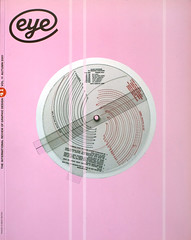Autumn 2001
Heavy breathing at the crystal goblet
Graphic Design & Reading: Explorations of an Uneasy Relationship
Edited by Gunnar Swanson<br>Allworth Press, £13.95<br>‘Graphic Design & Reading will be assigned reading for my graduate students this fall,’ announces the testimonial on the back cover from Laurie Haycock Makela, chair of the 2D (yes, even now!) department at Cranbrook. And this anthology of theory should be read - critically.
We are given a solid piece on advertising ‘inscriptions in painting’ by the dependable Johanna Drucker but without getting close to the objects discussed, and the book, sadly, includes no close reading of graphic design or typography. This is a pity, since the design of the book, by the editor Gunnar Swanson, could have served as a text for detailed reading: the intention to integrate side notes with text is worthy of respect. But is the coarseness of detail intentional – no hung quotes, no designed ‘signage’ of note numbers – or are the author’s intentions to be denied, in accordance with po-mo practice? Cursory examination reveals that what happens by chance in butting up the side-notes (in)to the text, could happen by design to provoke different readings, by elision or addition.
It is good to have Beatrice Warde’s The Crystal Goblet once more defending invisible typography, even with the editor’s whimsical queries as to her invisible underwear. It is also good to have Paul Elliman’s multi-disciplinary and programmatic celebration of the letter ‘e’, originally published here, in Eye no 33, vol.9. The reformed ‘e’ offered by Hrant Papazian, in ‘Improving the Tool? (the Latin alphabet)’ is as provocative to the eye as it would be to the wrist, but since Papazian wants to free us of manual constraints, neither RSI nor the drawn logic of letterforms is discussed apart from the opposition: similarity / difference. His ‘y’ is inverted left to right, again as if to free it from its written counterpart ‘ij’ as in Dutch and in roman numbering ‘xviij’ where the ‘j’ is a final-letter form - common to Arabic and Hebrew, written languages on which the author would have insights to offer.
The central question the collection is concerned to address, if timorously, is that of legibility in the postmodern world. It offers a survey of legibility studies by Rolf Rehef which doesn’t go beyond the early 1970s. It offers an acritical presentation of Derrida by Stephanie Zelman that ignores his essential sense of humour. It presents the cop-outs of responsibility without empowering its graduate student readers and the rest of us with the linguistic, cognitive and, dare I suggest it, poetic, theory to evaluate it. Ambiguities and polysemy have existed in literary texts for thousands of years before ‘layering’ was available on many a desktop. Hypertext, equally, is referred to here by David Small in his bilingual Talmud-Lechvinas project at the MIT Media Lab. What is surprising though, is the neglect of a (literary) translation model for the practice of graphic design, which is clear to any émigré designer (if it wasn’t before), or many designers outside of Anglosaxonia, who regularly work bi- or trilingually. Surprising, that is, if one forgets that this book started off as a museum project in Mid-America.
Swanson breathes heavily over Beatrice Warde’s idealised crystal goblet and its clear (unmacho) bright white wine; but in the real world, crystal is cut to remove the bubbles and refract the contents and the light. Not such a bad ambition for the designer after all.
Robin Fior, designer, writer, Lisboa, Portugal
First published in Eye no. 41 vol. 11, 2001
Eye is the world’s most beautiful and collectable graphic design journal, published quarterly for professional designers, students and anyone interested in critical, informed writing about graphic design and visual culture. It is available from all good design bookshops and online at the Eye shop, where you can buy subscriptions, back issues and single copies of the latest issue. You can also browse visual samples of recent issues at Eye before You Buy.

